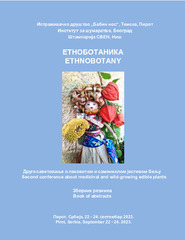Хималајски балзам као део флоре Сиринићке жупе: опасност или добробит?
Himalayan balsam in the flora of the Sirinić valley: a threat or a gain?
| dc.creator | Stanojević, Miloš | |
| dc.creator | Trailović, Maja | |
| dc.creator | Nikolic, Miroslav | |
| dc.creator | Papović, Olivera | |
| dc.creator | Nikolić, Nina | |
| dc.date.accessioned | 2023-10-02T06:07:05Z | |
| dc.date.available | 2023-10-02T06:07:05Z | |
| dc.date.issued | 2023 | |
| dc.identifier.isbn | 978-86-903786-1-6 | |
| dc.identifier.uri | http://rimsi.imsi.bg.ac.rs/handle/123456789/2127 | |
| dc.description.abstract | Летња терофита Impatiens glandulifera Royle (хималајски балзам, фамилија Balsaminaceae) потиче из уског подножја западних Хималаја, где се традиционално користи као лековита. Изван свог исходишта већ скоро два века колонизује углавном минералним хранивима (посебно азотом и фосфором) богата низијска крајречна станишта, и сматра се проблематичним освајачем који доводи до смањења биљне разноврсности, поспешивања ерозије и успоравања разлагања органске материје. Ова врста већ је инвазивна у преко 30 држава света, а Европска Комисија прогласила ју је за једну од најопаснијих инвазивних врста биљака1. У Србији, ова врста је још увек ретка и класификована је као „спорадично инвазивна“. Међутим, у изолованом планинском и природно олиготрофном станишту Сиринићке жупе (Косово и Метохија), атипичном за ову врсту, бројне и добро развијене састојине први пут смо регистровали 2021. године, углавном у долини реке Лепенац и њених притока (до 1200 m надморске висине) 2. 19 Приказаћемо сумаризацију резултата који су проистекли из мапирања распрострањености, анализе нативне вегетације у којој се јавља, карактеристика земљишта, морфологије самог „уљеза“ (висина, пречник стабла, сува маса јединке), као и знања локалног становништва о овој врсти. Хималајски балзам (локални назив „пуцавац“) донесен је у Сиринићку жупу почетком седамдесетих година прошлог века као украсна биљка, која је убрзо побегла из башти и дворишта. Њено даље ширење и трајно успостављање омогућено је драстичном деградацијом предела од стране човека, понајпре уништењем природне крајречне вегетације сечом шума и еутрофикацијом земљишта отпадним водама из домаћинства. У природну вегетацију која још увек није антропогено нарушена (ливадске и алувијалне састојине) ова биљка може спорадично да продре, међутим не и да се одржи. Дакле, иако се најкрупније јединке хималајског балзама са највећим потенцијалом за даљу инвазију налазе у најоштећенијој вегетацији (са најмањим диверзитетом), наши резултати указују да, за сада, ова декоративна и медоносна врста ту може евентуално да замени нитрофиле као што је коприва. Много је алармантнија, међутим, незаинтересованост млађе популације (до 30 година), која ову веома упадљиву врсту не примећује и не препознаје, што индиректно указује на општу ерозију традиционалног еколошког знања у овом подручју. | sr |
| dc.description.abstract | Summer therophyte Impatiens glandulifera Royle (Himalayan balsam, family Balsaminaceae) originates from a narrow zone in the foothills of the Western Himalaya, where it is used in traditional medicine. For almost two centuries it has been colonizing nutrient enriched (mainly with nitrogen and phosphorus) lowland alluvial habitats outside of its native range, and is currently considered a problematic intruder which causes decrease of plant diversity, promotes soil erosion and hampers nutrient cycling. This plant species has been classified as invasive in over 30 countries around the world, and considered one of top invaders of the European Union concern1 . In Serbia, it is still rather rare, classified as “sporadically invasive”. However, in an isolated mountainous habitat of the Sirinić valley (Kosovo and Metohija), naturally oligotrophic and atypical for this species, we have recently registered numerous and well developed stands of Himalayan balsam, predominantly in the alluvium of the Lepenac river and its tributaries (up to the elevation of 1200 m a.s.l.) 2 . We shall present the joint analysis of distribution mapping of the invader, its life history traits (height, stem diameter, aboveground dry weight), characteristics of the invaded domicile vegetation and concomitant soil properties, supplemented by the local knowledge on this species. 22 Himalayan balsam (vernacular name “pucavac” among the Serbian population) in the study area escaped from the gardens soon after deliberate introduction as an ornamental plant in the early 1970’s. Its further spread and successful establishment has been enabled by drastic anthropogenic landscape change and habitat degradation, primarily through severe deforestation of riparian vegetation coupled with the pronounced soil eutrophication by direct discharge of household wastewaters in the local river system. Interestingly, this species was able to sporadically occur, but not to get established in undisturbed natural vegetation like meadows or riparian forests. Thus, though the largest individuals of this intruder, implying its strongest potential for further spread, consistently occurred in the most degraded vegetation (with the lowest species diversity), our results suggest that under the current conditions this decorative, nectar producing species might substitute nitrophiles like stinging nettle in the secondary vegetation. Much severe risk might be the overall indifference of the younger population (under the age of 30 years), who do not recognize or even notice this rather conspicuous species, what indicates a general trend of erosion of traditional ecological knowledge in the study area. | |
| dc.language.iso | sr | sr |
| dc.publisher | Истраживачко друштво „Бабин нос“, Темска, Пирот | sr |
| dc.publisher | Институт за шумарство, Београд | sr |
| dc.rights | openAccess | sr |
| dc.rights.uri | https://creativecommons.org/licenses/by/4.0/ | |
| dc.source | Друго саветовање о лековитом и самониклом јестивом биљу | sr |
| dc.subject | инвазивна врста | sr |
| dc.subject | хималајски балзам | sr |
| dc.subject | традиционално еколошко знање | sr |
| dc.subject | invasive species / Himalayan balsam / traditional ecological knowledge | |
| dc.title | Хималајски балзам као део флоре Сиринићке жупе: опасност или добробит? | sr |
| dc.title | Himalayan balsam in the flora of the Sirinić valley: a threat or a gain? | |
| dc.type | conferenceObject | sr |
| dc.rights.license | BY | sr |
| dc.identifier.fulltext | http://rimsi.imsi.bg.ac.rs/bitstream/id/5648/bitstream_5648.pdf | |
| dc.identifier.rcub | https://hdl.handle.net/21.15107/rcub_rimsi_2127 | |
| dc.type.version | publishedVersion | sr |

